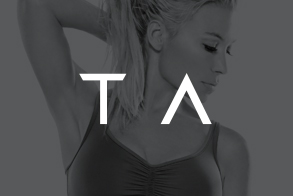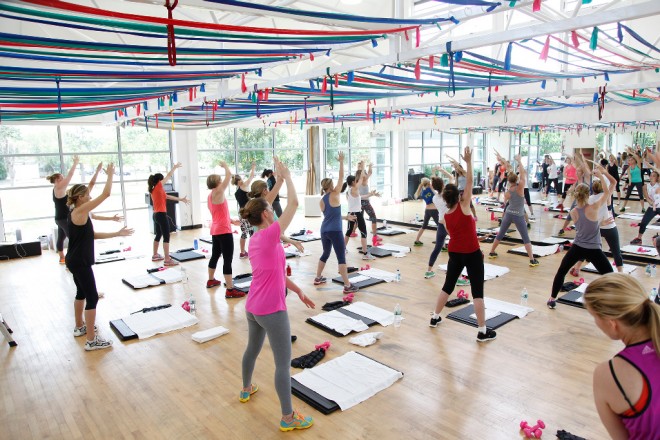A dancer’s life, much like a “normal” person’s life, takes many dips (undercurves)
…and turns (pirouettes).
It’s full of excitement and adventure. As dancers, I think that we are trained to deal with transitions (pliés in every class!)
…and dynamic changes (in artistry, in movement, and in life).
The performance practice challenges us to be constantly present and ready to improvise. One dancer who has transferred these skills into personal training is Kelly Markos.
 Kelly and I met while performing together at Busch Gardens Williamsburg. She had incredible technique and a personality on stage that would shine beyond the last row of seats. Off stage, she was generously willing to share her stories and experiences as a professional performer – an opportunity that I deeply craved and appreciated as a young professional. Several years later, Kelly was still willing to share her stories, mentorship, and moments of challenge and change with me as she transitioned from professional dance to personal training. Currently, she is a personal trainer in the Tracy Anderson Method.
Kelly and I met while performing together at Busch Gardens Williamsburg. She had incredible technique and a personality on stage that would shine beyond the last row of seats. Off stage, she was generously willing to share her stories and experiences as a professional performer – an opportunity that I deeply craved and appreciated as a young professional. Several years later, Kelly was still willing to share her stories, mentorship, and moments of challenge and change with me as she transitioned from professional dance to personal training. Currently, she is a personal trainer in the Tracy Anderson Method.
Kelly was always interested in fitness – her mother was a fitness instructor and Kelly often would watch her teach. As an adult and professional dancer, Kelly would take fitness classes to supplement her dance training. She reflects, “auditioning and attending company rehearsals was slowly taking its toll. It occurred to me one day that I was taking more fitness classes then dance classes. That was when I decided it was time for a change.”
The Tracy Anderson Method attracted Kelly because of its relationship to the physical body, to dance, and to its constant movement. According to Kelly and the official website, The Tracy Anderson Method contains programs and classes that “are designed to create balance where there is imbalance in the body.”
As dancers, we’re constantly fighting with some muscular systems that are over developed in strength and flexibility and others that are underdeveloped. Kelly says that, with the Tracy Anderson Method, “Every ten days content changes so that one does not plateau. This system creates a leaner physique.”
Kelly also notes that, as an instructor, she’s constantly learning new content. Like learning choreography, this consistent change in content and personal learning hones her attention to detail and allows her to be more effective in helping other people (dancers and non-dancers) change poor movement patterns and develop efficient strength and flexibility.
“There are so many muscles that are worked by this method that help with dance technique and longevity. There are not different class levels because the content changes every ten days…. It’s not easy!”
Because of this, the method would be appropriate for dancers and individuals of all skill and movement levels.
As a dancer and fitness instructor, Kelly understands the body’s ability to atrophy, or to lose strength and flexibility when not utilized. Therefore, Kelly suggests engaging in the Tracy Anderson Method six days a week, specifically because “we do not tear muscle with this method”. (Many training methods apply periods of intense activity that encourage muscle fiber tears at the cellular level followed by periods of rest and recovery allowing muscles to be repaired with increased strength or flexibility).
In traditional dance class, we do this on a micro level. For example, do you notice the “rest” that your body receives when a teacher is changing music, communicating with the accompanist, or confirming the combination in his/her own body before explaining it? These moments of rest allow muscles a moment to recover before engaging in strenuous activity, again, in short phrases and combinations. By focusing on the development of the strength of the small, deep muscle groups of the body, the Tracy Anderson Method helps an individual to re-define, re-align, and re-strengthen from literally, the inside out.
During training, the Tracy Anderson Method balances the body by developing relationships within the connections between the brain and the body.
There are online and in-person programs available.
Kelly reflected on her transition from professional dance to fitness: “I am pleased every time I see a client start to pick up dances. It makes me smile. Most of them have never danced before! To see them show confidence on the floor is amazing! … I know I made the right decision transitioning into fitness. I love people, I enjoy moving my body, I get to positively impact lives, and I can still have elements of dance in my life.”
Some personal equipment might be needed as designed by the specific programs of the Tracy Anderson Method. Kelly recommends light weights and good supportive shoes, especially for cardio vascular training.
As with previous article, I have not received compensation for exploring this option for dancers to cross-train. I am interested in exploring ways that professional dancers have continued to cross-train in order to feed their physical, artistic, and creative needs and appreciate Kelly’s willingness to share her experiences with the Tracy Anderson Method.
Have you tried the Tracy Anderson Method? Tell us about your experience.
Jessica C. Warchal-King is a Philly-based performer, choreographer, educator, and arts advocate. She is a member of Kun-Yang Lin/ Dancers and Nora Gibson Contemporary Ballet and has toured nationally and internationally. Jessica is co-founder and curator of the InHale Performance Series and she teaches at universities, studios, and arts centers.
Jessica earned her MFA in Dance from Temple and her BA in Dance and Anthropology from Muhlenberg College. She is a trained instructor in Dance for PD, a program developed by the Mark Morris Dance Group to bring dance to people with Parkinson’s Disease, and a Power Pilates Mat I & II Certified Instructor. The Embodiment Project is Jessica’s ongoing research project combining education, physical dance practice, and performance. Using dance as its medium, The Embodiment Project investigates the relationships between kinesthetic, somatic, and anatomical understanding, self-awareness, art-making, joy-creation, and social justice. www.jcwarchalking.blogspot.com


